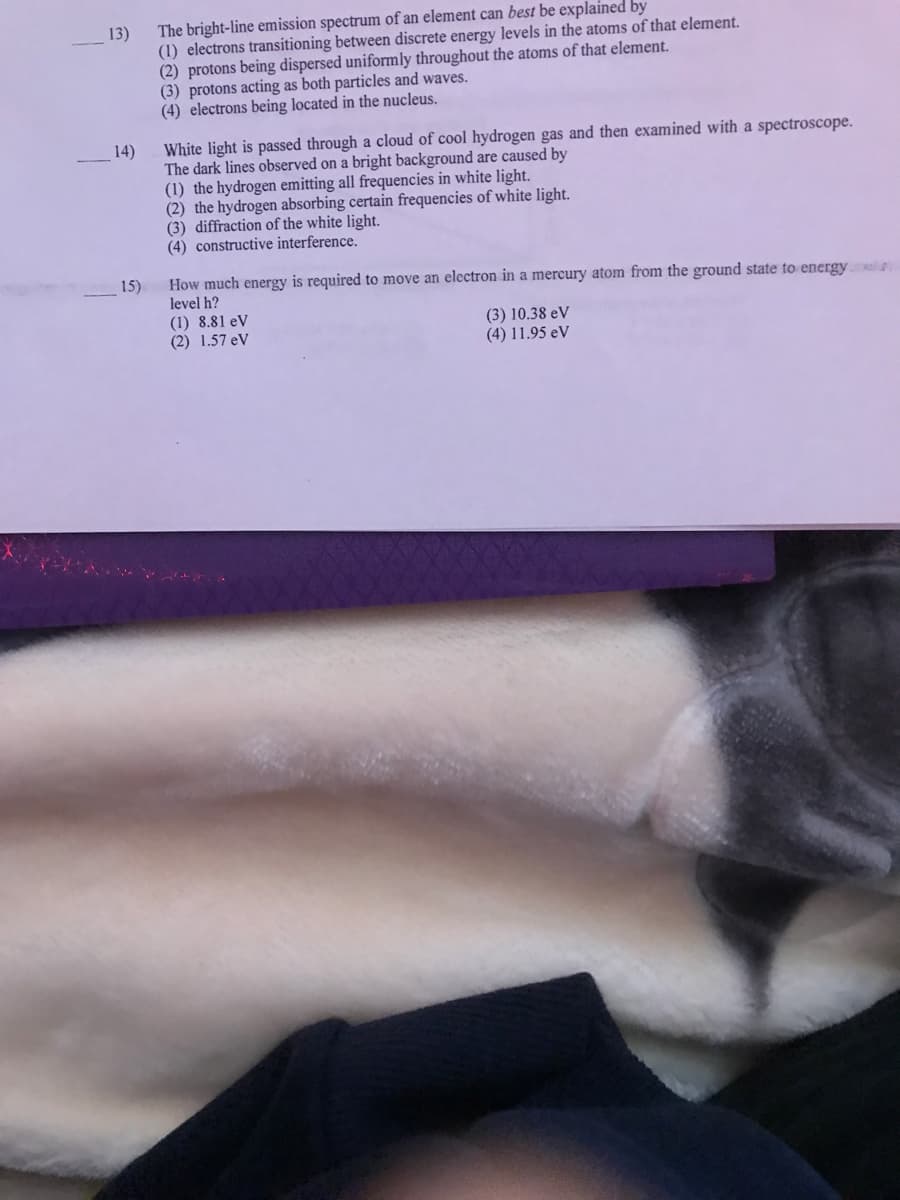The bright-line emission spectrum of an element can best be explålhe (1) electrons transitioning between discrete energy levels in the atoms of that element. (2) protons being dispersed uniformly throughout the atoms of that element. (3) protons acting as both particles and waves. (4) electrons being located in the nucleus. 13) _14) White light is passed through a cloud of cool hydrogen gas and then examined with a spectroscope. The dark lines observed on a bright background are caused by (1) the hydrogen emitting all frequencies in white light. (2) the hydrogen absorbing certain frequencies of white light. (3) diffraction of the white light. (4) constructive interference. How much energy is required to move an electron in a mercury atom from the ground state to energy level h? (1) 8.81 eV (2) 1.57 eV 15) (3) 10.38 eV (4) 11.95 eV
The bright-line emission spectrum of an element can best be explålhe (1) electrons transitioning between discrete energy levels in the atoms of that element. (2) protons being dispersed uniformly throughout the atoms of that element. (3) protons acting as both particles and waves. (4) electrons being located in the nucleus. 13) _14) White light is passed through a cloud of cool hydrogen gas and then examined with a spectroscope. The dark lines observed on a bright background are caused by (1) the hydrogen emitting all frequencies in white light. (2) the hydrogen absorbing certain frequencies of white light. (3) diffraction of the white light. (4) constructive interference. How much energy is required to move an electron in a mercury atom from the ground state to energy level h? (1) 8.81 eV (2) 1.57 eV 15) (3) 10.38 eV (4) 11.95 eV
Related questions
Question
This is a multiple choice with 3 parts so all parts need to be answered. They are not separate questions so this is not against guidelines. Please just give me the number of the questions and the letter of the answer, no need to do too much work. Thank you!!!

Transcribed Image Text:The bright-line emission spectrum of an element can best be explained by
(1) electrons transitioning between discrete energy levels in the atoms of that element.
(2) protons being dispersed uniformly throughout the atoms of that element.
(3) protons acting as both particles and waves.
(4) electrons being located in the nucleus.
13)
14)
White light is passed through a cloud of cool hydrogen gas and then examined with a spectroscope.
The dark lines observed on a bright background are caused by
(1) the hydrogen emitting all frequencies in white light.
(2) the hydrogen absorbing certain frequencies of white light.
(3) diffraction of the white light.
(4) constructive interference.
How much energy is required to move an electron in a mercury atom from the ground state to energy
level h?
15)
(1) 8.81 eV
(2) 1.57 eV
(3) 10.38 eV
(4) 11.95 eV
Expert Solution
This question has been solved!
Explore an expertly crafted, step-by-step solution for a thorough understanding of key concepts.
This is a popular solution!
Trending now
This is a popular solution!
Step by step
Solved in 2 steps
